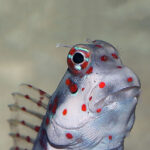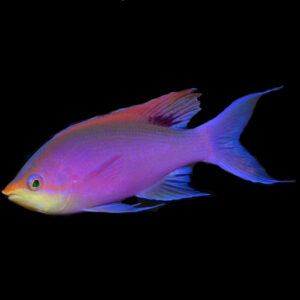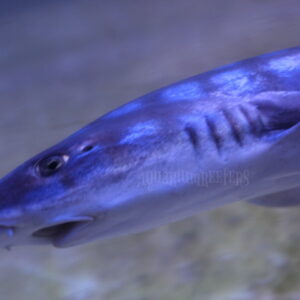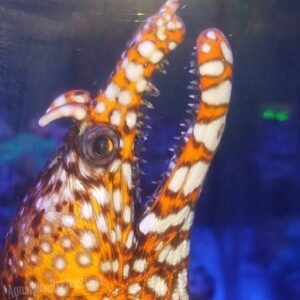Description
The Sulphur Goby, Cryptocentrus cinctus, also known as Yellow Watchman Goby, is a small and colourful fish that reaches a maximum size of approximately 2 inches (5 cm) in length. It has a slender body with a rounded head and a distinctive elongated first dorsal fin. The body colouration of the Sulphur Goby is vibrant, typically displaying a yellow or orange hue with intricate black markings, which may vary among individuals.
Natural Habitat.
The Sulphur Goby is native to the western Pacific Ocean, specifically found in the waters surrounding Indonesia and the Philippines. It inhabits coral reefs, lagoons, and other tropical marine environments characterized by a mix of sandy and rocky substrates. It seeks shelter among coral branches, rubble, or other crevices and can often be found near its symbiotic partner, the pistol shrimp.
Keeping the Sulphur Goby Healthy:
The care level for the Sulphur Goby is considered moderate, making it suitable for intermediate aquarists. It requires a well-maintained aquarium with stable water parameters and quality filtration. The Sulphur Goby is generally peaceful but may become territorial towards its own species or similar-looking fish. Providing ample hiding places and suitable tank mates can help alleviate aggression.
Special Requirements and Feeding.
The Sulphur Goby is a carnivorous species that feeds primarily on small invertebrates in the wild. In an aquarium setting, it should be offered a varied diet consisting of live or frozen foods such as brine shrimp, mysis shrimp, copepods, and other small crustaceans. Regular feedings throughout the day will help maintain its health and vitality.
How Many Should I Keep?
It is recommended to keep the Sulphur Goby individually or in pairs, as they can form monogamous pairs in the wild. This allows them to establish a stable hierarchy and engage in their natural behaviours without excessive territorial disputes.
Lighting Preference.
The Sulphur Goby thrives in aquariums with moderate lighting conditions. It does not have any specific lighting preferences but benefits from a well-balanced light spectrum that promotes the growth of live rock and corals, creating a natural environment.
Symbiotic Relationship with Pistol Shrimp:
The Dracula Goby has a fascinating symbiotic relationship with certain species of pistol shrimp. These two species form a mutualistic partnership where the goby acts as a lookout for the shrimp, while the shrimp excavates and maintains a burrow that both species share. The goby keeps watch for potential predators, and when it senses danger, it flicks its tail against the burrow’s rim to warn the shrimp and seek shelter together. This relationship provides protection for both the goby and the shrimp.
Suitable Tank Mates.
The Sulphur Goby is generally compatible with a variety of peaceful tank mates, including other reef-safe fish species. It can coexist with small-sized invertebrates and shrimps, but caution should be exercised if keeping it with larger or more aggressive fish that may pose a threat to its well-being.
Reproduction in the Wild.
The specific details of the Sulphur Goby’s reproduction in the wild are not extensively documented. However, as with other gobies, it likely follows a similar reproductive strategy. Gobies are known to be oviparous, with the female laying adhesive eggs that attach to the substrate or other surfaces. The male guards and tends to the eggs until they hatch into larvae.
Breeding Cryptocentrus cinctus:
-
- Setup:
Breeding the Sulphur Goby in a home aquarium requires careful planning and setup. Provide a well-maintained aquarium with suitable hiding places, such as caves or PVC pipes, to mimic their natural environment. Maintain stable water parameters, including a temperature range of 76-82°F (24-28°C) and a pH range of 8.1-8.4. Ensure the presence of a compatible pair, typically a larger female and a smaller male.
- Courtship and Spawning:
The courtship behaviour of the Sulphur Goby involves the male performing elaborate displays to attract the female. These displays often include rapid darting movements, fin flaring, and colour intensification. Once courtship is successful, the female deposits adhesive eggs on a suitable substrate or inside a chosen hiding place, while the male guards and defends the spawning site.
- Rearing Offspring:
After spawning, the male Sulphur Goby diligently guards the eggs and fans them with his pectoral fins to provide oxygenation. The eggs typically hatch within a week, releasing free-swimming larvae. Rearing the offspring from this stage requires specialized knowledge, as they have specific dietary and environmental requirements. Providing live rotifers, copepods, and other small planktonic organisms as food is crucial for their initial growth and survival.
Sexual Dimorphism.
The Sulphur Goby exhibits minimal sexual dimorphism, making it challenging to distinguish between males and females based on physical characteristics alone. However, size differences can sometimes be observed, with females tending to be slightly larger than males.
Distribution.
The Sulphur Goby, or Yellow Watchman Goby, is primarily found in the waters of the western Pacific Ocean. It naturally occurs in regions including Indonesia and the Philippines. While there may be captive-bred line bred strains available, the original fish comes from these wild populations.
Summary.
The Sulphur Goby, Cryptocentrus cinctus, is a small and colourful fish that reaches a maximum size of approximately 2 inches (5 cm). It requires a well-maintained aquarium with stable water parameters for optimal care. The Sulphur Goby is a carnivorous species that feeds on small invertebrates. It can be kept individually or in pairs, preferably with peaceful tank mates. Breeding the Sulphur Goby involves setting up a suitable environment, observing courtship displays, and providing care for the eggs and larvae. While minimal sexual dimorphism is observed, size differences may indicate the gender. The Sulphur Goby is naturally distributed in the western Pacific, with wild populations originating from regions such as Indonesia and the Philippines.
The Fish pictured here are representative only and the livestock you receive may vary in pattern, coloration, and shape.









Reviews
There are no reviews yet.